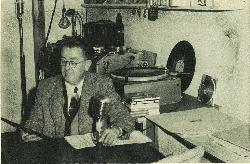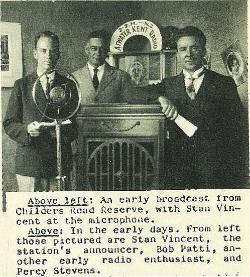A new thread to discuss New Zealand radio history.
Radio frequencies in New Zealand
from the NZ Listener (first published 25 November 1995)
Includes listings for Newstalk ZB, Radio Pacific and Radio Liberty.
When it came to talk radio, Radio Liberty was launched on 3 April 1995 as an alternative listening option to that of Newstalk ZB and Radio Pacific. The station was broadcast on 1386AM in Auckland and 1233AM in Wellington, in addition to new frequencies in Hamilton (576AM) and Christchurch (1323AM), but closed its doors less than a year later.
The 1386AM frequency in Auckland was used to launch Radio Tarana, which has been broadcasting to the city since. Over in Hamilton and Wellington, the frequencies were used to launch the Radio Rhema Broadcast Group’s Southern Star (now Star) network by 1997.
Today, Tarana broadcasts to Auckland on 1386AM and Star broadcasts to Hamilton on 576AM. Meanwhile, Magic Talk broadcasts to Wellington, New Zealand’s capital city, on 98.9FM (from the Kaukau and Haywards transmitters) and 1233AM (from the Horokiwi transmitter).
The 98.9FM signal covers the greater Wellington region and the Hutt Valley, and contrasts with More FM and The Breeze which broadcast on two frequencies each. For example, The Breeze can be found on 94.1FM (for coverage across the greater Wellington region) and 98.5FM (for the Hutt Valley and parts of the capital sheltered from the 94.1FM signal). The Breeze was also broadcast to the capital on 891AM until April 2015 when that frequency was used to launch the Magic network.
nice work
who was the 1st radio announcer you remember??
i always remember growing up with Merv smith on 1zb when i stayed over at my nanas
followed By the early 80s of radio hauraki
ie Kevin Black/fred botica
From what I actually remember listening to, probably James and Ken from 91ZM Christchurch… but you could just about pick anyone from 3ZB or 3ZE from the latter half of the 1980’s, and chances are I’ll remember their names, at least.
Constable Keith was always a fave.
Lovely find Paddy. Crazy to see how much local content was on ZB in those days compared to now, which is all network apart from Christchurch’s morning show and the local Saturday morning sports shows in certain markets.
I don’t think you’d get away with the Best of the week’s breakfast at midday on a Sunday anymore either.
I don’t quite remember but I think Baz and Johnno (Barry Corbett and John Dunne - Christchurch breakfast) were a simulcast across B98 (Classic Hits for a time as a strategy back when it was 3ZB/B98. The switch to a Newstalk format might have ended that.
While 1098 3ZB and B98FM operated separately for the majority of the time, some shows (including the weekday breakfast programme) were broadcast simultaneously on both stations. It was known as 3ZB98FM.
After 9am, both stations reverted back to their respective formats, with 3ZB featuring talkback and magazine-style programming while B98FM was more music oriented.
In 1993, the 1098 AM frequency was used to launch Newstalk ZB in Christchurch. Meanwhile, B98FM was rebranded as Good Time Oldies B98FM (which was a variation of the newly established Classic Hits brand, used only in Christchurch and Wellington).
In 1995, Good Time Oldies B98FM became known as Classic Hits 98FM, but changed its name to Classic Hits 97.7 in 2001. And in 2014, the Classic Hits network, as a whole, was rebranded as The Hits.
Not on ZB, but aren’t Magic Talk filling the 1pm-6pm slot on weekends with highlights of the AM show and talkback shows across the week?
Oh yeah! They are too.
Kind of a lazy strategy really given a lot would be out of date by then, or at the very least not as relevant as a live show.
Here’s a taste of what commercial radio in Taupo looked like during 1990/91. (Clipping courtesy of Taupo Times and special thanks to the late Mark Nicholls for the use of this photo.)
These days, The Hits Taupo (formerly 96.7FM Radio Lakeland) can be heard on 96.8FM and More FM Taupo (formerly Taupo’s 93.5 KIS FM), 93.6FM.
Was its failure due in part to carrying a name and motif that identified it more as a US station than an NZ one? Did it have a particular bent to its commentary or was it seen as fairly centrist?
![]()
![]()
![]()
![]()
![]()
Seeing some of the names on there like Lindsay Perigo and Deborah Coddington indicate to me it was probably more to the right of Newstalk ZB.
Yeah from what I’ve read it was very much a libertarian/ACT Party style viewpoint
Given Newstalk ZB and Radio Pacific owned the talk space, it was hard to break through with a third station, particularly one that shared a similar viewpoint to ZB in terms of politics.
When Merv Smith left Radio New Zealand’s (RNZ) station 1ZB in January, he turned Auckland radio upside-down. 1ZB’s ratings plummeted after changing its format and importing a new star. His name was Paul Holmes, transferred from 2ZB in Wellington.
Produced in-house by TVNZ and directed by Keith Hunter, The Rate Race was a documentary that looked at Newstalk 1ZB’s (now Newstalk ZB) struggle to claw its way back into the market. That documentary was broadcast on TV One (now TVNZ 1) at 9pm on the evening of Tuesday 15 December 1987 as part of its Tuesday Documentary slot.
Dedicated to the memories of Sir Paul Holmes and Merv Smith.
How can NZ On Screen claim those as early days of 1ZB? Try 90 years ago; it was broadcasting on 1090 kilocycles / 275 metres in 1926.
I think there were only a couple of months in it, but the Otago Radio Association’s 4ZC (AKA 4XC, 4ZB, Radio Alpha, Pioneer Radio &c &c &c) was very nearly not New Zealand’s first broadcasting station.
Percy Stevens, of Gisborne was granted license to broadcast in November 1923, that’s 97 years ago for those who’ve run out of fingers, and had it not been for a little rule regarding Radio Licensing, 2XM may still be with us today.
2YM, as it was first known, initially broadcast at 335 metres (about 890kHz) with a transmitter of 500 Watts. Heady stuff. By 1926 Percy was on 1200kc, not long after the station became 2ZM, and on one occasion was received as far away as South Australia.
Known as Atwater-Kent Radio from 1930, Percy boldly kept on broadcasting through record-copyright disputes, the Government’s desire to control radio and major earthquakes. In fact, Percy’s 2ZM was instrumental at relaying communications after the 1931 Napier earthquake, as well as numerous floods later on.
Refusing all Government offers to purchase his station, Percy remained as a non-commercial privateer, one of two in New Zealand (The other was 4ZC, as already mentioned). By the 1940’s the Government finally took the hint and subsidised both stations, although not to any generous level.
2ZM became 2XM in 1948, and having lived at 1150 on the dial for twenty years, Gisborne’s private station gained thirty kilohertz.
Percy wasn’t one for the microphone as such, and preferred the confines of his control room. A modest man, by all accounts, when he passed away in 1963, his station went with him, as ownership of Radio Broadcast Licenses then couldn’t be transferred. The NZBC started a new non-commercial station, making temporary use of 2XM’s equipment, and thus leaving one private radio station in the country.
Just think, 97 years ago…
Sources; Papers Past, NZ Yearbooks, Gisborne Photo News (photos of the station can be seen there)
A little about 5ZB…
5ZB? You probably know how NZ radio was divided into four regions, right? So where does 5ZB fit in, I hear you ask… well it sat atop the rails, of course!
The year was 1939, and the National Commercial Broadcasting Service (catchy name, eh?) wanted to know where to stick their next bunch of radio stations. So, to canvas advertising capacity, keen audiences and to work out reception, they teamed up with New Zealand Railways fit a Radio Studio inside a carriage (as you do).
The bright yellow spectacle, with collapsible mast on top, was spotted passing through Frankton Junction (Hamilton) on it’s way to Rotorua in April 1939, drawing much excitement. 5ZB launched in the stinky city (no offense) that Easter weekend, on 1360kc, booming out with 250W of power.
It stayed in Rotorua until April 12, and spent a couple of weeks in Hamilton, broadcasting between 7-9am, 12-2pm & 6-10pm (on the above Frequency). It was in Whangarei from 29 April, shot back through Auckland to Te Kuiti on 11 May, then to Taumarunui the day after.
5ZB continued down the West Coast, stopping at New Plymouth, Hawera and Wanganui before reaching Palmerston North on May 30. Because 2ZA broadcast on 1400kc, 5ZB was rebroadcast over 2ZA for the two days it was there.
The station then went on to Dannevirke, Napier and Hastings. A final stop in Masterton bought the tour to a conclusion in June 1939. In 79 days she covered 2650km of track and over 15000 people inspected the station.
The image below comes from the advertising (thanks Papers Past) that went ahead of the carriage for each town. Note; The actual carriage was not that curvy!

After the tour, 5ZB was setup at the NZ Centennial Exhibition in Wellington, broadcasting for the entire six months it was on (yes, even if the war was on, Hitler wasn’t going to stop little of NZ, eh!). During that time, 5ZB was on air from 3pm to 9:30pm daily, and the other ZB stations replayed content from the centennial throughout this period. Advertising apparently covered all 5ZB’s costs.
Once the Exhibition was over, the NZCBS decommissioned the station and Railways recoverted the carriage back to passenger configuration.
Various Sources - mainly Papers Past & a fascinating book on the Railway Studios (published 2020).
interesting to read about this “railway” station. In Victoria, country radio station 3YB also operated as a mobile station in the 1930s, broadcasting from various towns and locations not covered by existing radio stations. As fixed radio stations became more widespread, the need for a mobile service was less warranted so 3YB eventually settled in Warrnambool where it remains today, but is now 3YB FM.
Just a question from me, though. What is the protocol for NZ radio call-signs? I gather that the numeric prefix denotes the area or region but the letters always seem to begin with the letter “Z”?
Y = RNZ non-commercial stations
Z = RNZ commercial stations
(Of course ZM and ZB are no longer part of RNZ but retain the call sign (sans number) for historical/name recognition reasons)
From memory, X was granted to stations that started after Competition was allowed.



